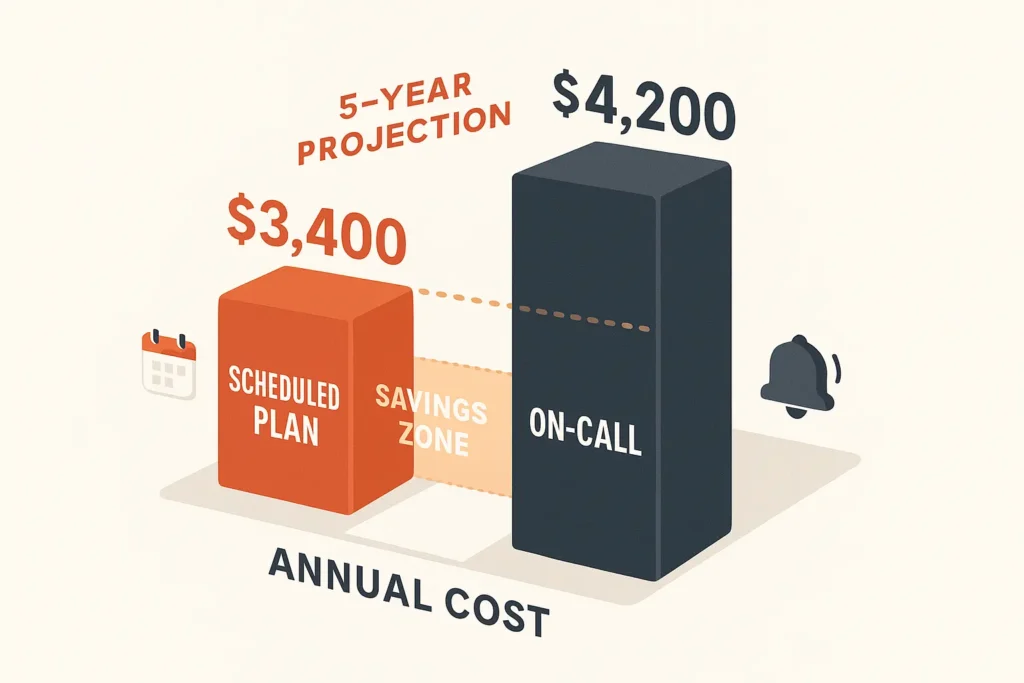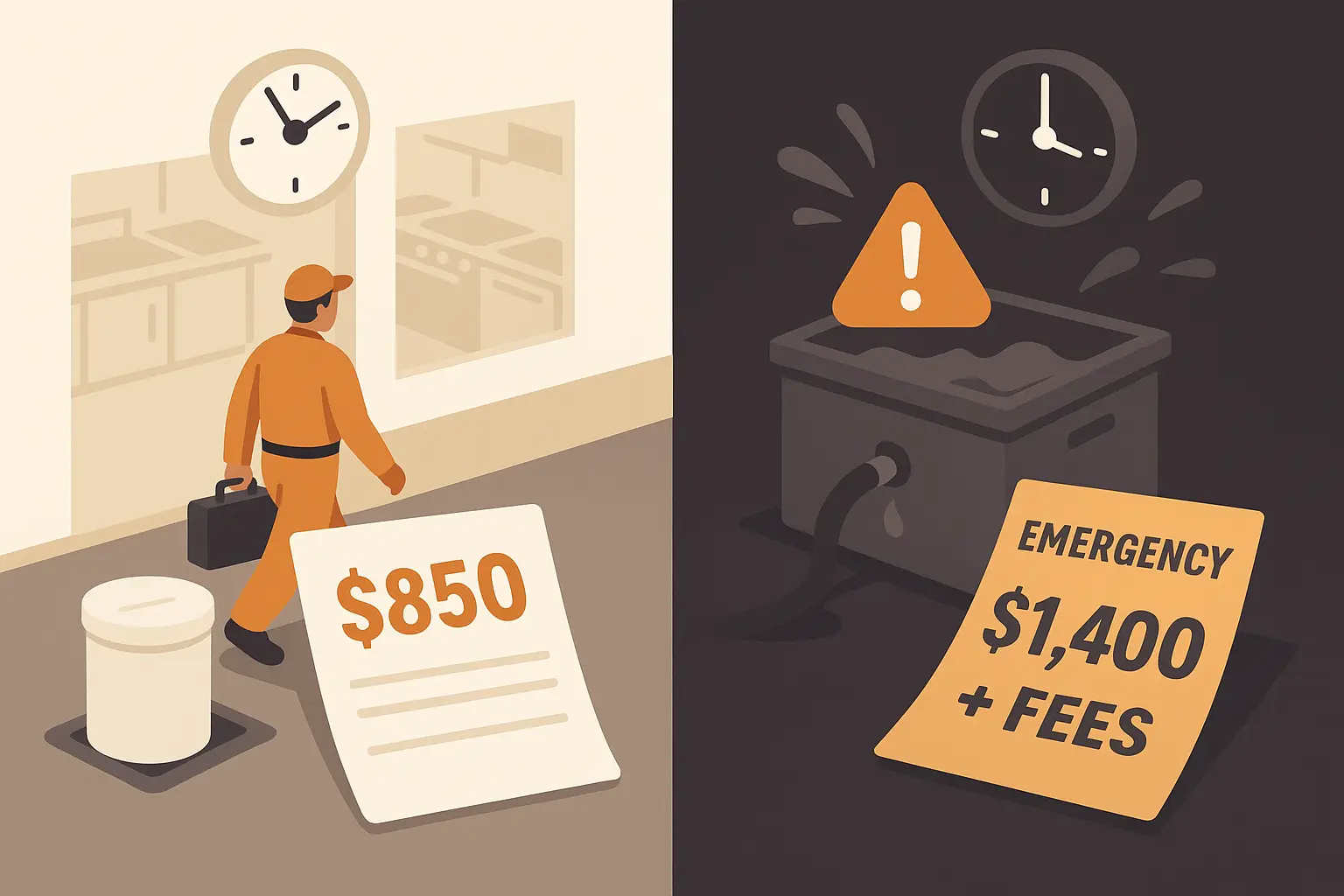Table of Contents
At a Glance: Why the Model You Choose Matters
Institutional kitchens can spend anywhere from $600 to over $10,000 per year on grease trap care, yet most of that swing comes down to how you schedule the truck. Scheduled service locks in a flat visit fee and prevents surcharges, while on call work adds emergency premiums, compliance risks, and staff overtime. Research across Florida, Georgia, and New Jersey shows scheduled plans average 20 to 40% lower per gallon than ad hoc calls and reduce fine exposure that can reach $25,000 per day for blockages.

The Real Question Behind the Budget
A cafeteria manager’s biggest fear isn’t today’s invoice, it’s the surprise invoice that blows next quarter’s capital plan. Scheduled cleaning gives finance teams a fixed line item, while on call work arrives only when alarms ring or inspectors knock. Florida saw more than $5M in sewer blockage penalties in 2024, most tied to overdue grease traps, according to state DEP reports. On call visits may feel flexible, but sticker shock plus lost meal service often wipes out any short term savings.
Scheduled Cleaning: Predictable Protection at a Lower Unit Price
When you commit to a recurring slot, used collection companies can route trucks efficiently and pass the savings on. National surveys peg indoor traps (20 to 100 gal) at $125 to $225 per visit and outdoor interceptors (500 to 1,500 gal) at $325 to $1,040 on a maintenance plan. Because grease levels stay below 25%, pumps run faster, meaning fewer labor hours and no solid waste surcharges. The result: lower carbon miles, consistent manifests for health officials, and an invoice your accountant can predict months ahead.
On Call Cleaning: The Premium You Don’t See Coming
Skip a cycle and the grease hardens. Now the truck must recirculate hot water, break crust manually, and haul heavier sludge. Research shows a neglected trap can cost up to three times the scheduled rate once solids exceed 25%. Add an emergency dispatch fee (often $200 to $400), night shift labor, and a city re inspection ticket, and a single overflow can swallow your yearly maintenance budget. Atlanta’s code, for instance, layers civil recovery fees on top of state fines for every sewer backup traced to an overdue trap.
Dollars & Sense: Sample Annual Cost Breakdown
| Service Model | Visit Frequency* | Per Visit Fee | Annual Total | Five Year Projection |
|---|---|---|---|---|
| Scheduled Plan | Quarterly | $850 | $3,400 | $17,000 |
| On Call / Emergency | 3× avg. per yr | $1,400 | $4,200 | $26,250 |

Costs & Penalties You Can’t Ignore
Florida counties fine between $250 and $5,000 for illegal grease discharges. Georgia statutes classify severe dumps as aggravated misdemeanors, climbing to $25,000 per day. New Jersey townships start at $100 for a first offense and escalate rapidly. Add sewer line jetting (≈ $800) and potential weekend catering refunds, and the “cheap” on call model can torch a week’s food budget. Scheduled service creates an audit trail of signed manifests that inspectors accept as proof of due diligence.
Regional Rate Factors: FL | GA | NJ
Florida: Senate Bill 1110 demands manifests from a licensed used collection company; statewide average scheduled fee sits at $175 to $325 depending on trap size.
Georgia: Many metro counties enforce a 14 day indoor cleaning rule; routes priced 10% lower when bundled with used oil pickup.
New Jersey: High disposal taxes bump outdoor interceptor fees 15 to 20% above national mean, but quarterly plans still undercut one off jobs by a third.
Knowing these levers lets you negotiate smarter and predict true lifetime cost, especially if you operate in multiple states.
Why Grease Connections Pricing Wins
Grease Connections routes roll through every major corridor from Miami to Newark daily, letting us bundle traps and used oil drums on one truck. Our Florida clients report 18% lower total FOG management spend after switching from on call vendors. In Georgia, our manifest API auto feeds county portals, avoiding late file fees entirely. With 24/7 monitoring and no surprise invoices, we turn grease from a reactive headache into a predictable, line item cost.
Build a Bullet Proof Budget in Five Minutes
- List each trap size and code required frequency.
- Multiply by the scheduled per visit fee in your state (see sections 2 & 6).
- Add 10% contingency for holiday capacity spikes.
- Subtract projected fines to see real savings.
Drop these numbers into your 2026 planning sheet or use our free calculator linked from each city page. With data in hand, finance can lock spending months before the fiscal year opens.
Ready for Predictable Pricing?
Grease Connections offers complimentary trap inspections and same day quotes across Florida, Georgia, and New Jersey. Email us or call the hub nearest you, and we’ll hold a rate for 30 days with no pressure, just transparent numbers you can take to the board.
Last reviewed June 29, 2025. Prices reflect 2025 market surveys and may adjust with fuel or disposal fees.









